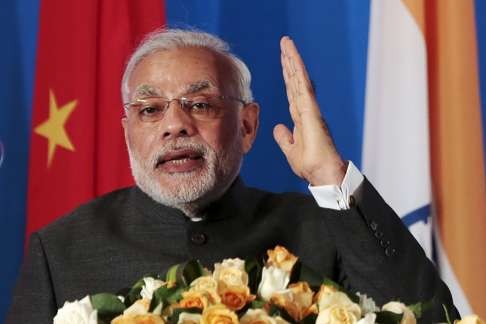
How China, Russia and India will seek to shape Eurasia in their own distinct ways
James Wertsch, Shen Dingli and Swaran Singh say India’s membership of the Shanghai Cooperation Organisation heralds a new geopolitical era, which will not be without its challenges given the three giants’ different visions
As India gains full membership of the Shanghai Cooperation Organisation (SCO) at its Tashkent summit this week, the move will provide a fillip to the long-standing strategic Russia-China-India triangle. It will also reinforce the organisation’s portrayal as Eurasia’s most potent strategic, economic political and military grouping, fast emerging as a counter to Nato’s eastward expansion. As the trio expands its influence across Eurasia, it is expected to further accelerate the exit of the US, EU and Japan. On the flip side, however, Russia, China and India not only have historical baggage, particularly a trust deficit, but they also carry very distinct visions of Eurasia, making them pursue varying trajectories.

India and Pakistan invited to join China and Russia in SCO security group
While Russia sees Eurasia in terms of its near abroad and seeks to reclaim the lost glory of a superpower, rising China has a clear strategic and commercial orientation. India seems restrained by its need not just to balance China and Russia but also to calibrate its engagement with the SCO with its newfound friendship with the US and Japan. Nevertheless, all three remain perfect candidates to address the SCO’s core agenda for Eurasia: expanding connectivity, energy security and countering terrorism. The pertinent question is: how will they blend their divergent strategies and fine-tune their deep-seated Eurasian paradigms to build the SCO into an effective platform for fostering peace and prosperity across Eurasia?
The US retreat from much of continental Asia also promises to accelerate China’s march West – the difference being that this advance is only economic and geopolitical
Beijing sees Eurasia in terms of its revival of the ancient Silk Road network which places China at the centre. This vision has gained steam under President Xi Jinping (習近平). China’s initiative is about obtaining access to energy by putting financial and human resources to work. The ambitious “One Belt, One Road” initiative calls for building a rail system from Xian to Rotterdam, involving massive numbers of Chinese workers and renminbi over the coming decades. While India remains reticent, Xi and Russian President Vladimir Putin last year agreed to connect the Belt and Road to the Russian-sponsored Eurasian Economic Union. The US retreat from much of continental Asia also promises to accelerate China’s march West – the difference being that this advance is only economic and geopolitical rather than military.

Closer trade ties top China’s agenda in Shanghai Cooperation Organisation talks
Moscow remains equally keen to develop energy reserves in the region and to cater to massive energy demand from China and India. But, for Russians, Eurasia has great political and cultural significance as well. Since the collapse of the USSR, Russians have been searching for an idea to renew national pride, reflected in the “neo-Eurasianism” movement, the roots of which go back to the 1917 Russian Revolution when many members of Russia’s intelligentsia became refugees in Europe. Neo-Eurasianists envision a civilisation whose geographical boundaries extend from Belarus and Ukraine in the West to Vladivostok and Alaska in the East and view it as destined to resist the military threats from “Atlanticist” forces in Europe and America. Their agenda stands in contrast to “One Belt, One Road”.
China’s Central Asia diplomacy can bring stability and growth
While Russia is a time-tested ally and major supplier of defence equipment to India, New Delhi’s partnership with China has also seen positive vibes, with expanding Chinese investment and technology transfers. India also views others in Eurasia as prospective partners for energy security and critical resources such as uranium. Entry into the SCO has immense potential for building connectivity, imparting military training, countering terrorism and reinforcing Afghan peace.
Throughout the 20th century, Eurasia received relatively little attention from the international community. This began to change in the 1990s, when the war in Afghanistan brought the US to the region.
Today, the US retreat holds promise of another major change in Eurasia’s future. China, Russia and India’s well-calibrated engagement offers unprecedented leverage in the region, even though blending their paradigmatic differences is a formidable challenge.
Professor James Wertsch is vice-chancellor (international relations) at Washington University. Professor Shen Dingli is associate dean at the Institute of International Studies, Fudan University, Shanghai. Professor Swaran Singh is chair of the Centre for International Politics, Organisation and Disarmament, at Jawaharlal Nehru University, New Delhi

